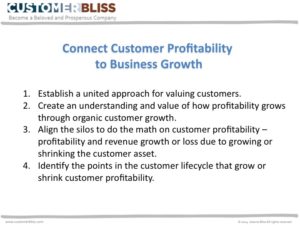The work of the Chief Customer Officer is about building the business through the growth of customer profitability and company revenue.
In order to connect customer experience to business growth, you need to move past the classic quarterly sales goals, production goals or operational objectives as the only metrics to define how the business is doing. Customer growth and profitability metrics must be part of the mix, and connected clearly to customer experience to warrant investment of people, time and financial resources.
- Do you know the volume and value of your incoming customers?
- Do you know the top five reasons that your customers left this quarter?
- Do you know how many complaints are occurring by category?
You have to make and prove the case to gain executive and board support. Know that this is job number one.
To make this case, I suggest you spend time to understand the different accounting methods throughout your company and to learn how and if customers are valued, tracked, and accounted for. This will likely be disjointed, and it will take real effort to tease out the information from throughout the organization. Establish a partnership with finance to cobble together the customer accounting approaches and establish a system for tracking customers and the cost to serve them.
The successful CCO creates a partnership with the operating leaders and CFO to accomplish four things:
1. Establish a united approach for valuing customers.
2. Create an understanding and value of how profitability grows through organic customer growth.
3. Align the silos to do the math on customer profitability – profitability and revenue growth or loss due to growing or shrinking the customer asset.
4. Identify the points in the customer experience lifecycle that grow or shrink customer profitability.
Read More:
Know Your Lost Customers – the Volume, Value and Why
Start Managing Customers as an Asset





Really excellent post. This speaks directly to the CCO managing profitability across the entire customer life cycle, and customer lifetime value, being especially careful to convert prospects who are the right ‘fit’ for the organization’s products and services in the first place. My colleague, Prof Peter Fader at Wharton, wrote a nice blog about this a couple of years ago, and I also had a related blog, “The Preoccupation With Pre-Customers”, which addressed the overfocus on prospects and the failure to have a recovery program for attractive former customers: http://customerthink.com/customer_development_skinny_on_fattening_up_customers/
Hi Jeanne
VALUE OF CUSTOMER VS: VALUE TO CUSTOMER
I have long been an advocate of customer value management. Despite there being very few case studies where it has worked outside of a pilot project. Very few of my large banking, telecoms or other data rich clients have a good understanding of who their customers are, let alone what their revenues are, what they cost the company and what risks come bundled with them; three of the core inputs to a Customer Lifetime Value calculation. And don’t even ask about the referral value and network value that can so easily distort customer valuations.
Let’s assume for the sake of argument that companies COULD calculate a robust lifetime value for their customers. Can the CCO (I met precious few of these too, thank goodness!) use the CLV data to better manage the customer experience. Well, yes, up to a point, but, not really. Let me explain. If a company is to do well it has to offer value to its customer before it can earn the right to extract value from them. Value is often revenues but it can also be information to drive innovation, relationships to drive repeat sales and recommendation to drive new sales. The exchange of value occurs each time the two interact, whether directly through marketing, sales or service interactions, or more likely, indirectly during the many interactions with the product or service when it is used. As Prahalad & Ramaswamy point out in an article on ‘ Co-Creation Experiences: The Next Practice in Value Creation ’, value is co-created one interaction at a time throughout the entire customer experience, not just at the point of sale.
Can you see the problem with CLV now? It is a one-sided measure. It is only about value for the company. You also need to understand how customers create value from all those interactions with the company, not just the value of customers to the company. In 25 years of high-end consulting I have only worked with one company that understood the value its customers created from interacting with it. Just one. The company? Toyota. No wonder Toyota has become No1 in the worldwide automotive industry.
Measuring CLV is certainly a part of managing customers for value. But understanding the value the company creates for its customers is even more important. As Sam Walton famously said, “Customers have all the best ideas. And they have all the money”. If they want either, companies had better understand what customers’ value and start giving it to them. Just like Toyota does.
Graham Hill
@grahamhill